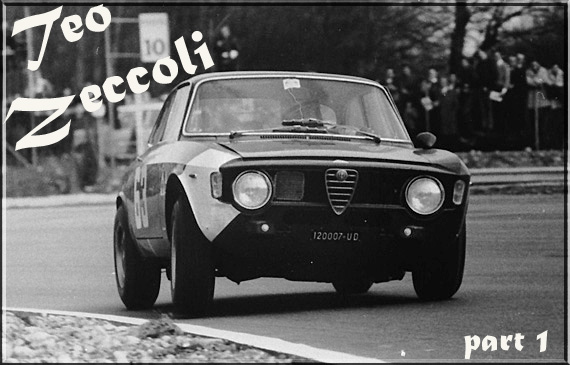
Zeccoli flat out at Spa in the Alfa Romeo GTA . (Zeccoli Archives, Alfa.)
Graham Gauld talks to Teodoro Zeccoli, Alfa Romeo’s test driver and team member.
In the alphabet of the world’s racing drivers, Teodoro Zeccoli comes somewhere near the end. He is a driver we have all heard about, due to his particular exploits with Alfa Romeo, but he is more than just a young Italian who grew up wanting to be a racing driver; Zeccoli was one of the favored test drivers of Carlo Chiti. Apart from being one of Chiti’s principals at Autodelta he was also the test driver for Chiti’s Formula 1 bad-egg, the ATS.
Zeccoli was one of a group of young Italian hotshoes who came to light in the 1960s that included Spartaco Dini, Ignacio Giunti, Roberto Bussinello and Nanni Galli.
I met up with him about ten years ago at his svelte BMW dealership in Imola, within earshot of the Enzo and Dino Ferrari Circuit. Though in his seventies, the tall and elegant Zeccoli was at first perplexed that anyone should want to know about his racing, but it was clear his racing years were dear to him.
The back wall of his dealership had an array of trophies, photographs and certificates highlighting his racing career. There were diplomas from the Automobile Club of Milan naming him Italian 1600cc Sports Car Champion in 1966 (Abarth), Touring Car Champion in 1970 (Alfa Romeo) and Sports Car Champion in 1971 (Alfa Romeo) and photographs of him racing all over the world.
Born in 1929 in Lugo, near Imola, Zeccoli did not fancy joining his father in the family business – which was making saddles for motorcycles – but had a passion for racing. His first race car was a Zagato-bodied Ermini Fiat 1100TV that he ran successfully in hill climbs and races during 1957. Later he had a Fiat 8V Zagato which he bought second-hand from a local Fiat dealer, and such was his success in events that he was approached by Sig. Dei of Scuderia Centro Sud to drive an OSCA MT4 in the Grand Prix of Liberation in Havana, Cuba. This race was put on by
Castro to celebrate the overthrow of the Cuban government. Zeccoli finished 9th in the class driving a three-year-old Tipo S 1500 version of the OSCA MT4 (Chassis 1179).
Chassis 1179 had originally been a factory car raced by Giulio Cabianca, the late Colin Davis and the great Lodovico Scarfiotti, who had bought it from the factory to race as a private owner. By 1960, though entered by Centro Sud, the car was actually owned by Gianni Brichetti.
Brichetti also owned an 1100cc MT4 (Chassis 1144). Zeccoli drove this car in Italian events including the Shell meeting at Vallelunga on May 22, the Trento-Bondone hill climb on July 10th where he placed 5th in class, and he placed 4th in class at the Trofeo Val D’Intelvi on June 12 with the faster Tipo S. Zeccoli entered four more events with the Tipo S and was getting noticed. He only raced in 1960 with the OSCAs before being recruited by Abarth for their factory team and this led to his Italian Championship in 1961.
Originally Zeccoli was approached by Enzo Ferrari, but nothing came of it. He signed for Abarth instead, which had a heavy program of events, particularly hill climbs, which he enjoyed. In May that year he was paired with German driver Herbert Linge in a Fiat Abarth 1000 and finished second in his class just behind class winners Giancarlo Rigamonti and Jean Guichet in another Abarth 1000. Zeccoli spent two years as a factory driver with Abarth.Luciano Greggio in Abarth, The man, the machines lists the following class victories for Zeccoli:
1961
Aug 6 Sestriere Hillclimb, 850 TC Abarth, first in 850 class
Oct 24 Montlhery, France 1000km Paris GT 1000cc class, Fiat Abarth Bialbero 1000
1962
April 15 Digne, France, Touring 850 cc, Fiat Abarth 850TC
May 13 Avusring, Germany, GT class, 700cc Fiat Abarth700 BA
May 20 Villefranche-sur-Saone Touring 850cc Fiat Abarth 850TC
ATS Test Driver
Around this time Carlo Chiti approached Teodoro Zeccoli to be test driver for both the ATS Grand Prix car and the GT. While Zeccoli was busy racing Abarths, Chiti was involved in the famous palace revolt at Ferrari, when a number of the key people were dismissed by Enzo Ferrari. Two of them were engineer/designer Chiti and team manager Romolo Tavoni. Another was Gerolamo Gardini, the Commercial Manager. He set about trying to find jobs for everyone, and approached a trio of industrialists led by Count Volpi, Giorgio Billi and Bolivian tin millionaire Jamie Ortiz Patino with a plan to design and build not only a GT car but a Grand Prix car for 1963.
There were many hurdles on the way to actually producing these cars. For example, Billi held the majority of shares, but Volpi wanted the cars to be called Serenissimas after his own team. There were a lot of wrangles which ended with Volpi withdrawing from the group almost before they had started. The company was then Automobili Turismo Sport or ATS, and work started on an ambitious factory on the outskirts of Bologna. At one early stage Billi was approached by Alfa Romeo for ATS to take over Alfa Romeo’s motor sport program, but Billi wanted to go it alone.
Despite the problems, for Chiti it all sounded too good to be true and he immediately got down to the task with his usual boundless enthusiasm, even though he was working out of a temporary cabin in the yard. In 1963 the ATS GT car was displayed at the Geneva Motor Show and the Grand Prix car the same month at Monza.
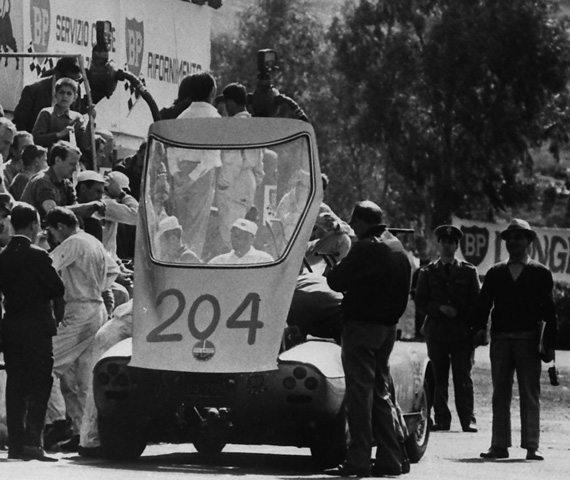
A pit stop on the Targa Florio with the lightweight aluminium bodied ATS GT, which was raced in 1964. (Zeccoli Archives)
The problem of who was to drive the Grand Prix car was made simple. Enzo Ferrari had fired all his drivers. Chiti approached Phil Hill and Giancarlo Baghetti to be the factory ATS drivers. However, the whole affair was a bit of a disaster.
Zeccoli has little to say about it all. He actually did very little testing of the Grand Prix car but helped persuade Billi that a lightweight version of the 2500cc GT car might do well. Two of them turned up at the Targa Florio that year, one driven by Piero Frescobaldi and Giancarlo Baghetti and the other by Zeccoli and Paolo Gardi, but neither car finished. Later that season, one of the cars was loaned to ex-Stirling Moss mechanic Alf Francis, who entered it for the Reims 12 hour race with Zeccoli and the Portuguese driver Mario Cabral. The team was involved in a road accident and the car did not start. It was its last appearance as an ATS.
All that Zeccoli will say about the ATS was that the car had promise but the aluminium cylinder block was always very fragile and the budget was such that there were always little problems with it.
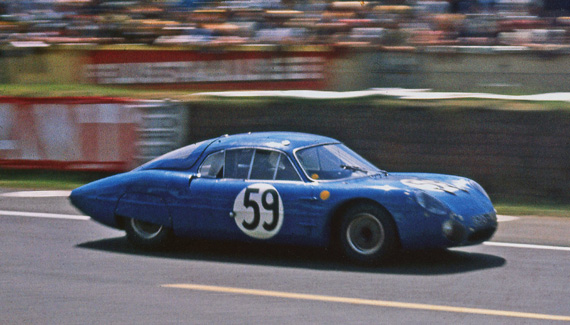
The Zeccoli/Masson M64 Alpine at Le Mans in 1964. The team would finish a credible 20th overall, fifth on the Index of Performance after suffering ignition problems. Photo CD courtesy Roy Smith, Alpine and Renault V1.
In 1964 Zeccoli raced at Le Mans with Roger Masson in his Renault Alpine and did a few races in Alpines. He would soon be back with Chiti and another adventure, this one being much more successful, as well see in Part 2 of Talking with Teodoro Zeccoli.
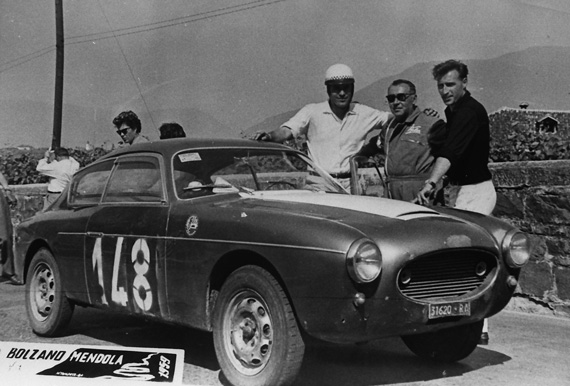
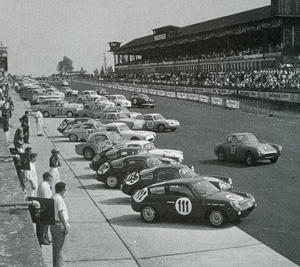
The photo of the Abarth 1000 twin cams lined up at the “ring” shows the cars with their rear hoods closed. All of the factory cars in the U.S. came with their rear decks propped up by a permanent tubular structure. I wonder why.
That’s easy – HEAT
Another great article, I’m looking forward to part 2.
Mr Falk, it appears only the 111 car has the “hood” closed.
I’m looking at the gaps in the number circles on the other cars.
I’ve heard from reliable sources that the decks were propped open because they went faster that way.
Interesting article,looking forward to part 2